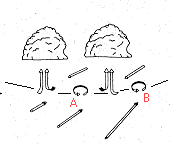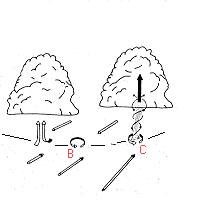Bobby Prentice
The October 26, 2006, southwest Kansas landspout tornado outbreak has sparked a lot of discussion. I thought it would be appropriate to begin a thread that provided a review and further insight into the non-supercell tornado (landspout/waterspout) forecast problem.
A landspout is a form of non-supercell tornado occurring with a parent cloud in its growth stage (e.g., towering cumulus) and with its vorticity originating in the atmospheric boundary layer. Waterspouts are another form of non-supercell tornado and basically form the same way.
ORGANIZING STAGE
Landspouts/waterspouts form along convergent, horizontal wind shear boundaries where cumuliform clouds are rapidly growing. Small atmospheric boundary layer vortices called misocyclones form and propagate along these boundaries (particuarly near boundary intersections).

The "[FONT=Verdana, Arial, Helvetica, sans-serif]0-3km CAPE (J/kg) and Sfc Vorticity" graphic from the SPC Hourly Mesoanalysis [/FONT]web page provides perhaps the best weather chart to see this enviroment in real time. This page is generally best because it includes national mesonet surface data (from MesoWest) and RUC model data in its analysis. Here is an example from the 10/26/2006 southwest Kansas landspout outbreak:
0-3km[FONT=Verdana, Arial, Helvetica, sans-serif] CAPE (J/kg) and Sfc Vorticity, 10/26/2006, 21z[/FONT]
MATURE STAGE
A landspout/waterspout may form when a convective updraft becomes co-located with one of these misocyclones. The landspout/waterspout circulation developes from the ground upward as the pre-existing vertical vorticity is streched by the updraft. The horizontal diameter of the misocyclones decreases which increases the rotational velocity of ciruclation. This is process is analogous to a figure skater which spins faster and faster as she brings her arms in closer to her body. The strongest rotation remains below the cloud base in the atmospheric boundary layer.

Here is a picture of one of the October 26, 2006 southwest Kansas landspouts from Jon Davies excellent case study page at: http://members.cox.net/jondavies6/102606swks/102606swks.htm

WSR-88D radar loops and 1 km rapid-scan visible satellite loops are necessary for further interrogation and detecting fine scale details in growth and development.
DISSIPATION STAGE
Precipitation induces a downdraft within the vortex. The landspout/waterspout weakens and its vertical exent is reduced as the cumuliform cloud's updraft weakens.
One of the biggest problems warning forecasters experience is the landspout/waterspout has often dissipated when a precipitation echo has reached the surface. However, is one landspout/waterspout has developed the mesoscale environment is often primed for more to form.
FORMATION CLUES
Favorable radar indicators for non-supercell (landspout/waterspout) tornado development include:
- Boundaries exhibiting strong horizontal wind shear
- Collision points of two or more boundaries (example)
- Boundaries possissing wave-like inflections (scalloped appearance) suggesting circulations
- Rapidly developing storms near low-level circulations
- Region along a boundary possessing high radar dBz reflectivity values in clear air return (signature of strong convergence)
- Boundaries with high radar specturm width values (which imply strong wind shear)
RADAR DETECTION PROBLEMS
- Landspouts/waterspouts may form before any precipitation echo has developed.
- The small horizontal extent of the circulation limits the detectable range.
- The strongest rotation is confined to low levels (the atmospheric boundary layer). Thus, radar horizon problems prevent us from seeing boundaries beyond about 50-60 miles from the radar and misocyclones beyond about 20-30 miles.

A landspout is a form of non-supercell tornado occurring with a parent cloud in its growth stage (e.g., towering cumulus) and with its vorticity originating in the atmospheric boundary layer. Waterspouts are another form of non-supercell tornado and basically form the same way.
ORGANIZING STAGE
Landspouts/waterspouts form along convergent, horizontal wind shear boundaries where cumuliform clouds are rapidly growing. Small atmospheric boundary layer vortices called misocyclones form and propagate along these boundaries (particuarly near boundary intersections).

The "[FONT=Verdana, Arial, Helvetica, sans-serif]0-3km CAPE (J/kg) and Sfc Vorticity" graphic from the SPC Hourly Mesoanalysis [/FONT]web page provides perhaps the best weather chart to see this enviroment in real time. This page is generally best because it includes national mesonet surface data (from MesoWest) and RUC model data in its analysis. Here is an example from the 10/26/2006 southwest Kansas landspout outbreak:
0-3km[FONT=Verdana, Arial, Helvetica, sans-serif] CAPE (J/kg) and Sfc Vorticity, 10/26/2006, 21z[/FONT]
MATURE STAGE
A landspout/waterspout may form when a convective updraft becomes co-located with one of these misocyclones. The landspout/waterspout circulation developes from the ground upward as the pre-existing vertical vorticity is streched by the updraft. The horizontal diameter of the misocyclones decreases which increases the rotational velocity of ciruclation. This is process is analogous to a figure skater which spins faster and faster as she brings her arms in closer to her body. The strongest rotation remains below the cloud base in the atmospheric boundary layer.

Here is a picture of one of the October 26, 2006 southwest Kansas landspouts from Jon Davies excellent case study page at: http://members.cox.net/jondavies6/102606swks/102606swks.htm

WSR-88D radar loops and 1 km rapid-scan visible satellite loops are necessary for further interrogation and detecting fine scale details in growth and development.
DISSIPATION STAGE
Precipitation induces a downdraft within the vortex. The landspout/waterspout weakens and its vertical exent is reduced as the cumuliform cloud's updraft weakens.
One of the biggest problems warning forecasters experience is the landspout/waterspout has often dissipated when a precipitation echo has reached the surface. However, is one landspout/waterspout has developed the mesoscale environment is often primed for more to form.
FORMATION CLUES
Favorable radar indicators for non-supercell (landspout/waterspout) tornado development include:
- Boundaries exhibiting strong horizontal wind shear
- Collision points of two or more boundaries (example)
- Boundaries possissing wave-like inflections (scalloped appearance) suggesting circulations
- Rapidly developing storms near low-level circulations
- Region along a boundary possessing high radar dBz reflectivity values in clear air return (signature of strong convergence)
- Boundaries with high radar specturm width values (which imply strong wind shear)
RADAR DETECTION PROBLEMS
- Landspouts/waterspouts may form before any precipitation echo has developed.
- The small horizontal extent of the circulation limits the detectable range.
- The strongest rotation is confined to low levels (the atmospheric boundary layer). Thus, radar horizon problems prevent us from seeing boundaries beyond about 50-60 miles from the radar and misocyclones beyond about 20-30 miles.


